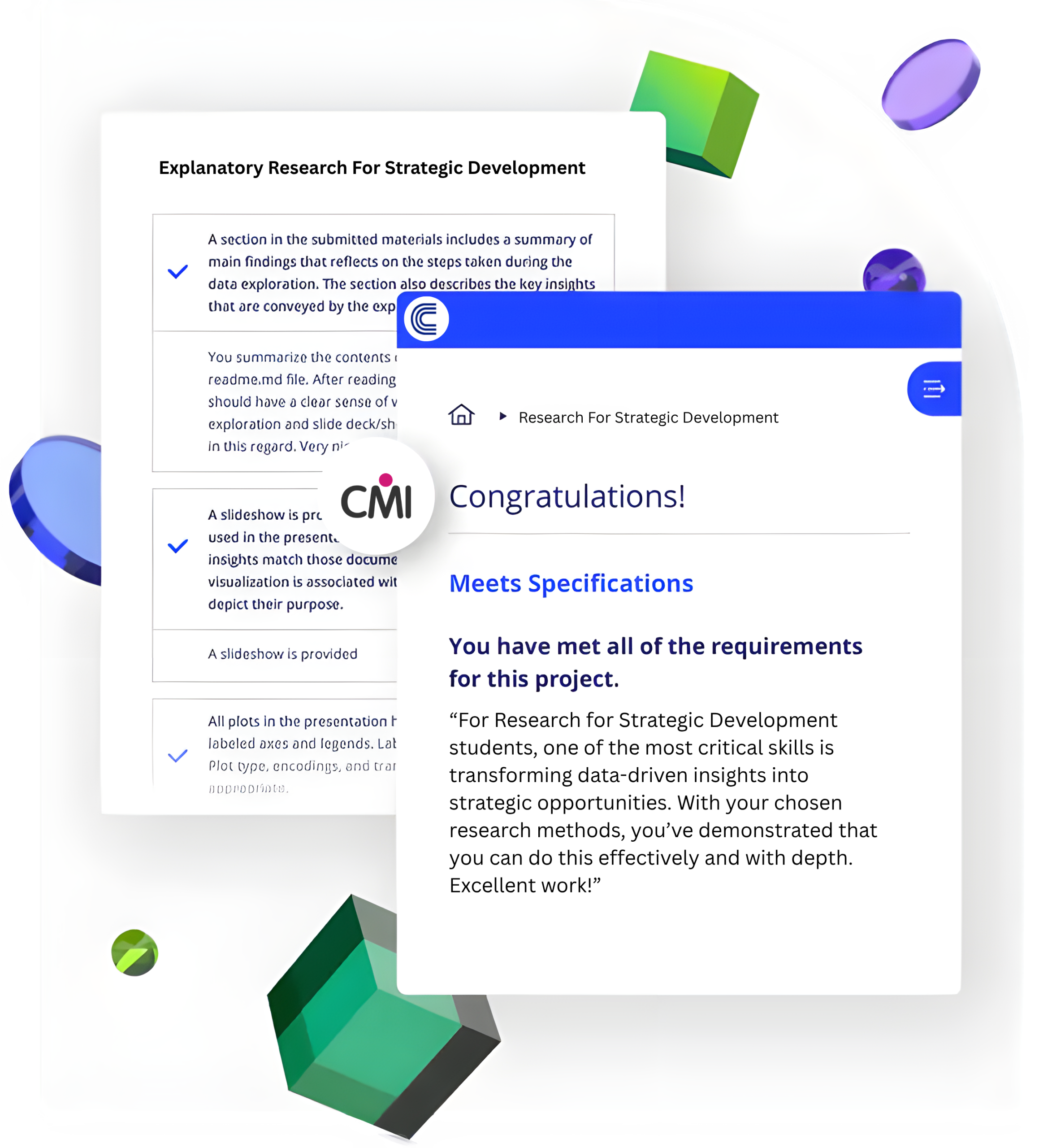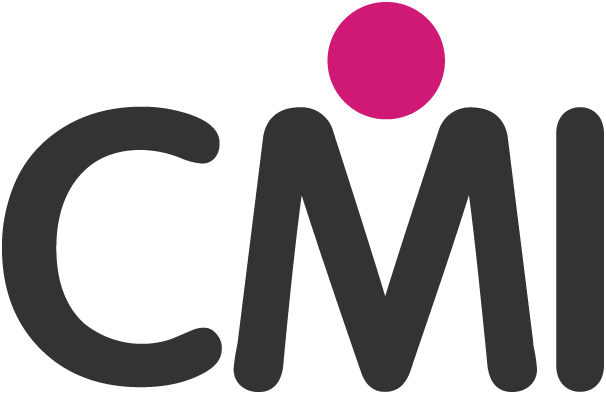- Subsidiary from The E Platform FZC, UAE.
- [email protected]
- +971-569-541-842
Categories
Professional Certificates
Research For Strategic Development Professional Certificate
4.5 (59 Rating)
Duration:
15س
Enrolled: 75
- Program Language: Arabic and English
- Study Method: Self-study with personalized follow-up sessions from our experts
- Access Duration: 3 Months
- Level: Mid to Senior-Level Professionals
- Certification: CMI Certificate
Why Earn a CMI-Accredited Research for Strategic Development Professional Certificate?
- Globally Recognized Research Credential: Achieve prestigious international recognition from CMI, highlighting your expertise in strategic business research.
- Advanced Analytical Skills: Develop specialized skills in strategic research and data-driven decision-making, significantly enhancing organizational competitiveness and innovation.
- MBA Program Alignment: Covers 10% of the accredited MBA program curriculum, paving the way for advanced academic opportunities and career progression.
- Exclusive Strategic Research Resources: Gain one year free access to ManagementDirect, providing comprehensive resources on research methodologies, competitive analysis, and strategic intelligence.
- Flexible Learning with Expert Support: Engage in self-paced study complemented by tailored expert sessions, conveniently aligned with your professional schedule.

Learning Outcomes
Research methodology proficiency
Book A Session and Improve your skills!
Strategic planning
Book A Session and Improve your skills!
Data analysis skills
Book A Session and Improve your skills!
Market trend anticipation
Book A Session and Improve your skills!
Communication of research findings
Book A Session and Improve your skills!
Innovation techniques
Book A Session and Improve your skills!
Competitive analysis
Book A Session and Improve your skills!
Research proposal development
Book A Session and Improve your skills!
Project management
Book A Session and Improve your skills!
Problem-solving
Book A Session and Improve your skills!
Course Curriculum
Unit 1: Research Proposal
Learn how to construct a compelling research proposal that outlines objectives, milestones, and funding opportunities, ensuring alignment with organizational goals.
-
Module Introduction
-
Unit intro
-
Unit Objectives
-
Lesson 1: Research Proposal – Index
-
Lesson 1: What is a research proposal?
-
Lesson 1: Components of Research proposals.
-
Lesson 1: Components of a Research Proposal – Further Readings
-
Lesson 1: What is the aim of research?
-
Lesson 1: Tips on how to write research aims – Further readings
-
Lesson 1: Stages of Research
-
Lesson 1: Research Proposal
-
Lesson 1 :Quiz
-
Lesson 2: Business Objectives For Project Proposals – Index
-
Lesson 2: What are SMART objectives?
-
Lesson 2: What is the Terms of Reference?
-
Lesson 2: What is the Rationale for the research?
-
Lesson 2: Ethical Considerations in Research
-
Lesson 2: Types of ethical issues
-
Lesson 2: Objectives and goals: Writing meaningful goals and SMART objectives – Futher readings
-
Lesson 2: What Are Ethical Considerations in Business Research – Futher readings
-
Lesson 2: Research – Video
-
Lesson 2 :Quiz
-
Lesson 3: Tools to collect information for Strategic Development – Index
-
Lesson 3: What is strategic development?
-
Lesson 3: Organisational analysis of the culture & structure.
-
Lesson 3: Growth Strategy
-
Lesson 3: Operational issues report
-
Lesson 3: SWOT & PEST Analysis.
-
Lesson 3: Customers and key stakeholders analysis.
-
Lesson 3: Competitive Analysis.
-
Lesson 3: How to conduct A competitive analysis?
-
Lesson 3: How to conduct a competitive analysis in 6 easy steps – Further readings
-
Lesson 3: Research Tools – Video
-
Lesson 3 :Quiz
-
Lesson 4: Research Project Planning Part 1 – Index
-
Lesson 4: What is a research project plan?
-
Lesson 4: What are research project milestones?
-
Lesson 4: How to assess risk and manage a research project?
-
Lesson 4: More readings: on how to assess and manage risk in Projects – Further Readings
-
Lesson 4: What are the critical pathways in Project planning?
-
Lesson 4: How to Use Critical Paths in Microsoft Project – Video
-
Lesson 4: How to create a contingency plan for your research project?
-
Lesson 4: How to create a heatmap in Excel – Further Readings
-
Lesson 4: How to create a contingency plan – Further Readings
-
Lesson 4: Case study
-
Lesson 4 :Quiz
-
Lesson 5: Research Project Planning Part 2 – Index
-
Lesson 5: How to access information for your research project?
-
Lesson 5: How to access data for your research project – Further Readings
-
Lesson 5: What is Project communications management?
-
Lesson 5: How to come up with a communication plan for your research project?
-
Lesson 5: Example
-
Lesson 5: How to Handle the sensitivity of information gathered during project planning?
-
Lesson 5: The 5 best ways to handle sensitive data – Further Readings
-
Final Exam
Unit 2: Research Methodology
Discover how to select the right methodology for research objectives. This module ensures the collection of relevant, reliable data for crafting effective business strategies.
-
Unit Intro
-
Unit Objectives
-
Lesson 1: Research Methods – Index
-
Lesson 1: What are Research Methods?
-
Lesson 1: What are Research Methodologies?
-
Lesson 1: Differences between research Methodologies and research methods
-
Lesson 1: Types of research methods- Surveys
-
Lesson 1: More readings on Surveys – Further readings
-
Lesson 1: Types of research methods- questionnaires
-
Lesson 1: Types of research methods- Observations
-
Lesson 1: Types of research methods- Case study
-
Lesson 1: More readings on case studies – Further Readings
-
Quiz Lesson 1
-
Lesson 2: Data Quality testing & Data types
-
Lesson 2: What is data?
-
Lesson 2: Research Budgeting – Video
-
Lesson 2: Primary and Secondary data – Primary Data
-
Lesson 2: Advantages and Disadvantage of primary research data
-
Lesson 2: Case study on Primary research – Further readings
-
Lesson 2: Primary and Secondary data – Secondary research data
-
Lesson 2: Advantages and Disadvantage of Secondary research data
-
Lesson 2: Diffrence Between Primary & Secondary Research
-
Lesson 2: Qualitative Vs. Quantitative types of data.
-
Lesson 2: Qualitative Data
-
Lesson 2: Quantitative Data
-
Lesson 2: More readings on Qualitative and Qualitative research – Further Readings
-
Lesson 2: Latest trends in Data collection
-
Lesson 2: More reading on Chat GPT – Furthe Readings
-
Lesson 2: Literature review
-
Lesson 2: Literature review – Video
-
Lesson 2: Evaluating the Literature review
-
Lesson 2: Ways of Data quality testing
-
Lesson 2: 3 Shades of Data Accuracy
-
Lesson 2: More readings on data quality testing – Further Readings
-
Lesson 2: Research – Video
-
Quiz Lesson 2
-
Lesson 3: Referencing Sources – Index
-
Lesson 3: What is referencing and citation?
-
Lesson 3: How to incorporate sources in your research project?
-
Lesson 3: What are referencing styles?
-
Lesson 3: Types of referencing styles
-
Lesson 3: More about types of referencing styles – Further readings
-
Lesson 3: Reasearch tools – Video
-
Quiz Lesson 3
-
Final Exam
Unit 3: Sampling Techniques
Master the art of sampling by selecting representative groups and determining sample sizes that yield reliable results, minimizing errors in strategic research.
-
Unit intro
-
Unit Objectives
-
Lesson 1: Sample Size – Index
-
Lesson 1: What is the sample size?
-
Lesson 1: What are the terms used around the sample size?
-
Lesson 1: Nature of Population – Video
-
Lesson 1: Example
-
Lesson 1: Sample size calculation
-
Lesson 1: Calculate the sample size
-
Lesson 1: Here are the steps to calculate the sample size
-
Lesson 1: Why do you need to determine the sample size?
-
Lesson 1: Sample Research – Video
-
Lesson 1 : Quiz
-
Lesson 2: Sampling Techniques – Index
-
Lesson 2: What is sampling?
-
Lesson 2: Major sampling techniques – Non-probability
-
Lesson 2: Major sampling techniques – Probability
-
Lesson 2: Sampling techniques applications -Simple Random Sampling
-
Lesson 2: Sampling techniques applications -Stratified Random Sampling
-
Lesson 2: Sampling techniques applications – In convenience Sampling
-
Lesson 2: Sampling techniques applications – Quota Sampling
-
Lesson 2: More readings on types of Sampling Techniques in Data Analytics You Should Know – Further Readings
-
Lesson 2: Probability & non probability – Video
-
Lesson 2: Quiz
-
Final Exam
-
Unit outro
Unit 4: Data Analysis
Analyze and validate data to uncover insights that inform strategy implementation and drive business decisions.
-
Unit Intro
-
Unit Objectives
-
Lesson 1: Data validation – Index
-
Lesson 1: What is data analysis?
-
Lesson 1: What is data cleaning?
-
Lesson 1: What is data quality and why is it important? – Further Readings
-
Lesson 1: Cleaning Data In Excel – Video
-
Lesson 1: What is exploratory data analysis?
-
Lesson 1: What is a pivot table?
-
Lesson 1: How to create a pivot table in excel – Video
-
Lesson 1: Quiz
-
Lesson 2: Data Analysis – Index
-
Lesson 2: Qualitative data analysis (QDA)
-
Lesson 2: Quantitative Data Analysis
-
Lesson 2: Qualitative data analysis methods – Content Analysis
-
Lesson 2: Example – Lexalytics
-
Lesson 2: How to plan and perform a qualitative study using content analysis – Further Readings
-
Lesson 2: Qualitative data analysis methods – Thematic analysis
-
Lesson 2: Qualitative data analysis methods – Narrative analysis method
-
Lesson 2: Qualitative data analysis methods – Grounded theory analysis method
-
Lesson 2: Qualitative data analysis methods – Discourse analysis method
-
Lesson 2: More readings on Discourse analysis – Further readings
-
Lesson 2: How to Manually code your Qualitative data?
-
Lesson 2: Steps of Manually code your Qualitative data
-
Lesson 2: Application of qualitative data analysis on businesses (Case study)
-
Lesson 2: Quiz
-
Lesson 3: Data interpretation – Indx
-
Lesson 3: What is quantitative data analysis?
-
Lesson 3: Quantitative data analysis methods
-
Lesson 3: Descriptive Vs. Inferential statistics
-
Lesson 3: Some common statistical tests used in descriptive statistics
-
Lesson 3: Example in excel
-
Lesson 3: Types of Inferential Statistics
-
Lesson 3: Case study
-
Lesson 3: Example of A/B Tests
-
Lesson 3: 6 new trends in market research – Further Readings
-
Lesson 3: Quiz
-
Lesson 4: Forecasting and Predictive Analytics – Index
-
Lesson 4: What is forecasting?
-
Lesson 4: Types of Forecasting- Qualitative forecasting
-
Lesson 4: Qualitative forecasting methods – Further Readings
-
Lesson 4: Types of Forecasting- Qualitative forecasting
-
Lesson 4: Quantitative forecasting methods – Time series forecasting
-
Lesson 4: Excel – Time Series Forecasting – Video
-
Lesson 4: Quantitative forecasting methods – Exponential smoothing forecasting
-
Lesson 4: Quantitative forecasting methods – Moving average forecasting
-
Lesson 4: How to calculate moving average in excel – Video
-
Lesson 4: Quantitative forecasting methods – Associative model forcast
-
Lesson 4: What is trend analysis?
-
Lesson 4: Trend analysis uses
-
Lesson 4: Trend Analysis in Excel – Video
-
Lesson 4: Quiz
-
Lesson 5: Data visualisation – Index
-
Lesson 5: What is data visualistion?
-
Lesson 5: Types of data visualisations
-
Lesson 5: Case study on Data visualisation
-
Lesson 5: More readings on Uber data visualisation team – Further Readings
-
Lesson 5: Types of Data Patterns
-
Lesson 5: How to present your data in PowerPoint for storytelling?
-
Lesson 5: Common mistakes in data visualisation
-
Lesson 5: Quiz
-
Final Exam
-
Unit outro
Unit 5: Reflection and Case Study
Conclude the research process with a focus on reflection and application, synthesizing findings through real-world case studies.
-
Unit Intro
-
Unit Objectives
-
Lesson 1: Reflection – Index
-
Lesson 1: Reflection and case study
-
Lesson 1: The steps of Reflection
-
Lesson 1: Receiving feedback on research papers.
-
Lesson 1: More readings on feedback – Further readings
-
Lesson 1: Quiz
-
Lesson 2: Improving research skills – Index
-
Lesson 2: How to improve your research skills?
-
Lesson 2: More readings on research skills – Further Readings
-
Lesson 2: Research Resources
-
Lesson 2: More readings on feedback – Further Readings
-
Lesson 2: Quiz
-
Lesson 3: Case Study – Index
-
Lesson 3: Unilever Case study
-
Lesson 3: Lipton Case study
-
Lesson 3: Lipton Case study – Situational analysis
-
Lesson 3: Lipton Case study – Set up the target audience
-
Final Exam
Testimonials
"In-depth exploration into market trends, competitor analysis, and innovative solutions – this course offers it all!"
Reem Al-Fahad
"Every strategic decision I make is now backed by solid research, thanks to the principles I learned here."
Khaled Al-Thani
"The Research for Strategic Development Course is a perfect blend of academic rigor and industry relevance."
Mariam Al-Khawaja
"Research was always about numbers and data. This course made it about stories, insights, and strategic growth."
Waleed Al-Jaber
Elevate Your Career




